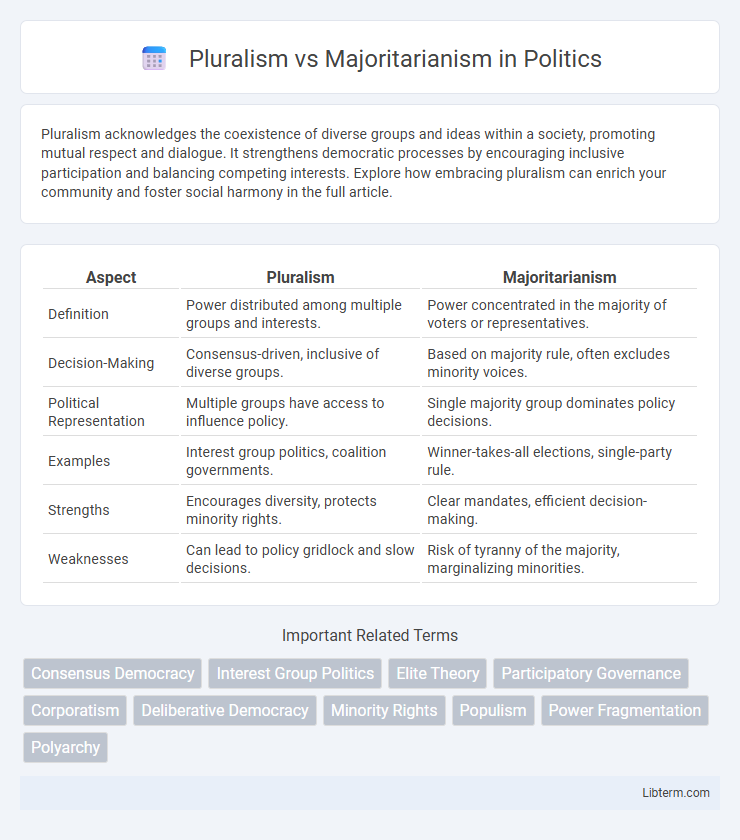Pluralism acknowledges the coexistence of diverse groups and ideas within a society, promoting mutual respect and dialogue. It strengthens democratic processes by encouraging inclusive participation and balancing competing interests. Explore how embracing pluralism can enrich your community and foster social harmony in the full article.
Table of Comparison
| Aspect | Pluralism | Majoritarianism |
|---|---|---|
| Definition | Power distributed among multiple groups and interests. | Power concentrated in the majority of voters or representatives. |
| Decision-Making | Consensus-driven, inclusive of diverse groups. | Based on majority rule, often excludes minority voices. |
| Political Representation | Multiple groups have access to influence policy. | Single majority group dominates policy decisions. |
| Examples | Interest group politics, coalition governments. | Winner-takes-all elections, single-party rule. |
| Strengths | Encourages diversity, protects minority rights. | Clear mandates, efficient decision-making. |
| Weaknesses | Can lead to policy gridlock and slow decisions. | Risk of tyranny of the majority, marginalizing minorities. |
Introduction to Pluralism and Majoritarianism
Pluralism emphasizes the coexistence and competition of diverse interest groups within a political system, ensuring that no single entity holds absolute power. Majoritarianism advocates for decision-making based on the majority's preferences, often prioritizing the interests of the largest group over minority voices. Understanding the foundational principles of pluralism and majoritarianism is essential for analyzing different democratic systems and their approaches to representation and governance.
Defining Pluralism: Core Principles
Pluralism is defined by its core principles of recognizing a diversity of groups, interests, and identities within a society, promoting equal participation and power-sharing. It emphasizes the decentralization of authority and the protection of minority rights against the dominance of a single majority. Pluralism supports an inclusive political framework where multiple voices contribute to decision-making processes, ensuring democratic representation and social coexistence.
Key Features of Majoritarianism
Majoritarianism emphasizes the principle that the majority's preference should prevail in decision-making processes, often resulting in a single-party or dominant-group rule. Key features include majority rule, centralized authority, and limited power-sharing, which can marginalize minority groups and reduce pluralistic representation. This approach prioritizes efficiency and clear accountability but risks undermining political diversity and minority rights.
Historical Context and Evolution
Pluralism and majoritarianism have evolved through distinct historical contexts that shaped democratic theory and practice. Pluralism emerged prominently in the early 20th century as a response to the limitations of majoritarian rule, emphasizing the role of diverse interest groups in influencing policy and protecting minority rights. Majoritarianism, rooted in classical democratic theory dating back to ancient Athens, prioritizes rule by the majority and has adapted over time through constitutional safeguards and electoral reforms to balance majority power with minority protections.
Decision-Making Mechanisms Compared
Pluralism emphasizes diverse interest groups influencing decision-making through bargaining and compromise, ensuring multiple voices shape policy outcomes. Majoritarianism centers on majority rule, where decisions reflect the preferences of the larger population, often via direct voting or elected representatives. Pluralist mechanisms promote inclusivity and negotiation, while majoritarian approaches prioritize simplicity and clear mandates from the majority.
Representation in Government Structures
Pluralism in government structures promotes diverse representation by ensuring multiple groups and interests have influence in decision-making processes, preventing dominance by any single faction. Majoritarianism prioritizes the preferences of the majority, often leading to a concentration of power that may marginalize minority voices and reduce the breadth of representation. Effective governance often requires balancing pluralistic inclusivity with majoritarian efficiency to foster fair and accountable political representation.
Strengths of Pluralist Systems
Pluralist systems excel at accommodating diverse interests by encouraging multiple groups to participate in political decision-making, which enhances democratic representation and reduces the risk of tyranny by any single majority. These systems promote negotiation and compromise among various stakeholders, leading to more balanced and inclusive policies. Furthermore, pluralism fosters political stability by preventing polarization and ensuring that minority viewpoints are considered in the governance process.
Criticisms of Majoritarian Approaches
Majoritarianism faces criticism for marginalizing minority groups and ignoring diverse perspectives within a society, often leading to the tyranny of the majority. Critics argue that it undermines pluralistic values by prioritizing the preferences of the largest group over minority rights and interests. This approach can result in policies that lack inclusivity and fail to address the needs of all stakeholders in a democratic system.
Real-World Case Studies: Pluralism vs Majoritarianism
Pluralism in real-world democracies is exemplified by India, where multiple ethnic, religious, and linguistic groups coexist with institutional mechanisms ensuring minority rights and representation. Majoritarianism is evident in countries like Turkey, where policies favor the dominant ethnic group, often marginalizing minorities and consolidating political power within the majority community. These case studies reveal how pluralism promotes inclusive governance through power-sharing and plural representation, whereas majoritarianism tends to centralize authority, sometimes at the cost of minority exclusion and social cohesion.
Future Challenges and Opportunities
Pluralism faces future challenges in managing increasingly diverse societies where multiple interest groups demand representation, requiring innovative governance models that balance inclusivity and efficiency. Majoritarianism confronts the risk of marginalizing minority voices, which can lead to social fragmentation and political instability, prompting opportunities to integrate more participatory decision-making processes. Both frameworks must adapt to digital transformation and globalization, leveraging technology to enhance democratic engagement and address complex policy issues.
Pluralism Infographic

 libterm.com
libterm.com